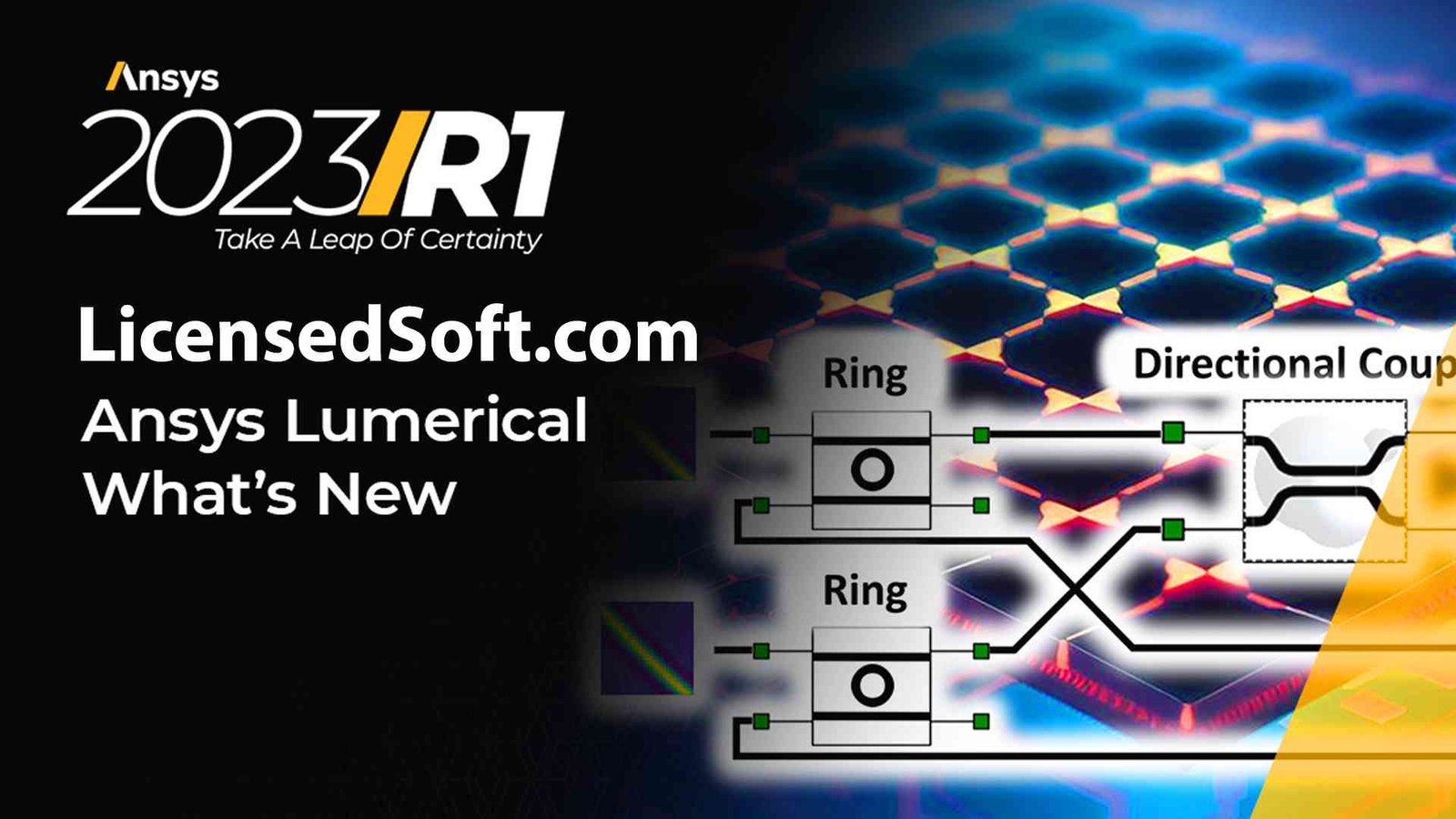ANSYS Lumerical 2023 version is an industry-leading photonic simulation software, Ansys Lumerical provides researchers and engineers with a simulation environment dedicated to photonic device, circuit and system design, used in advanced fields of photonic science and material processing, such as AR /VR, digital imaging, solar energy and quantum computing, etc.
Since its founding in 2003, Ansys Lumerical has become a leader in photonic simulation. Ansys Lumerical has customers in more than 50 countries around the world, including 10 of the top 15 large enterprises in the S&P 1200 Global IT Index and 47 of the top 50 research universities in the Times Higher Education World University Rankings. Cited in more than 13,500 scientific journals and patents, Ansys Lumerical is one of the most widely cited tools in the photonics community.
ANSYS Lumerical 2023 New Features:
1. CMOS image sensor
The growing interest in imaging applications in gesture sensors, machine vision and 3D imaging has led to intensive research into high-performance CMOS image sensor architectures.
2. Diffractive optics and metal sense
Diffractive optical elements (DOEs) and metasurfaces are being explored for planar imaging applications, including augmented reality and biomedical devices
3. Integrated photonic components and circuits
Photonic integrated circuits hold great promise for applications ranging from data center communications to environmental and biosensing and quantum computing. You can also get ANSYS Electronics Suite 2023 R1 By LicensedSoft.
4. LED/Organic Light Emitting Diode
To provide brighter and more efficient light sources, researchers are exploring how to use nanophotonics in light-emitting diode (LED) and organic light-emitting diode (OLED) structures.
5. Metamaterials and Plasma
Many high-impact opportunities exist for plasmonics and engineered photonic materials such as metamaterials in next-generation photonic devices and sensors
6. Photovoltaic power generation
To improve efficiency and reduce material costs, research is increasingly focused on new solar cell design concepts.
7. Photon inverse design
Given the desired target performance, computational methods can employed to find the optimal device geometry.
8. Laser
Combine the accuracy of physical simulation with the performance and scale of photonic integrated circuit simulation.

What’s New in ANSYS Lumerical 2023
1. Sharing function
Ansys Licensing Integration
Ansys-Lumerical tools are integrated with Ansys License Server. Users can now connect to Ansys License Manager when using an enterprise license, or continue to use their existing commercial licenses on the Lumerical license server.
New version control scheme
Starting with the 2020 R2 release, Ansys-Lumerical products adopt the versioning scheme used by all Ansys tools. Since this is the second major release for the 2020 calendar year, it is labeled 2020 R2.
Safe Mode in Scripts
A new “Safety Mode” provides users with enhanced security against malicious scripts. Safe Mode is turned on by default in all Ansys-Lumerical products and prevents attackers from accessing or modifying system files.
MPI and firewall exception options
The 2020 R2 version of the Windows installer allows users to choose which MPI packages to install and which firewall exceptions to apply. By default, the MS-MPI package is installed and no firewall exceptions are applied.
Performance Improvements to PID Mesh and Gradient Calculator
Limited diff mesh from 2020 R2 to use CPU more efficiently, with better threading support and performance improvements. When using conformal meshes in CAD or engines with multiple threads, users can expect modest speedups, especially for projects with complex geometries. Users who choose Photonic Inverse Design to compute gradients using an accurate volume-averaged mesh technique will see significant speedup and improved accuracy.
2. Equipment kit
FDTD engine can calculate port mode From R2 2020
Port, source and display release, mode calculation can done in FDTD engine. Mode recalculations required due to changes in geometry or simulation settings are no longer performed immediately. As the simulation runs, the engine will recalculate any simulation mode information that needs to updated. This change allows users to create, save, and update projects faster, and offload larger pattern calculations to remote engines. Note that users will still have the option to calculate pattern information from CAD, scripts that check pattern information in CAD will have the same functionality.
Documentation Improvements for Photon Reverse Engineering
The documentation for the Python API and lumopt has greatly improved with a landing page that directs you to relevant resources such as: Photon Reverse Engineering Overview 9 and Getting Started with lumopt 3. Additionally, the application example for designing a photonic inverse design 1 grating coupler has significantly updated with a more complete and detailed workflow.
Blocking Thermal Resistance with Fixed Temperature Boundary Conditions
Fixed temperature boundary condition objects in the CHARGE and HEAT solvers can now add aggregated thermal resistances at the boundaries. This enables the user to simulate a practical device with a heat sink away from the simulated structure by simulating the system outside of the simulated area by mixing a thermal resistor (connecting it to the heat sink). Check out this new feature in this App Gallery sample 4.
Changes to Stackdipole and stackpurcell script commands
As part of this release, there are some conceptual changes to the STACK dipole commands (Stackdipole and stackpurcell) to only accept and return physical quantities. Previously, users would specify dipole orientation as non-polarized, vertically polarized, or S&P horizontal. As a 1D solver (this means cylindrical symmetry)
Thus, the accepted orientation parameters are now “vertical” (“vert”), horizontal (“horz”), and “random” (or “rand”), which is a superposition of the former two.
Support for background material in FDTD
The FDTD solver object now allows the user to select a background material from the material database. This will enable users to easily use dispersed materials as background materials in FDTD simulations.
Calculation of FDTD Port Group Delay
FDTD ports can now calculate group delay. When the user enables group delay calculation, the solver adds two additional frequency points around the center of the simulated band to accurately calculate group delay. The user can control the spacing of these additional points for improved accuracy from the Advanced tab of the FDTD solver properties editor.
3. System kit
List of single-configuration networks co-emulated by Virtuoso
Virtuoso Co-Simulation now allows users to set up individual HED netlist configurations for hierarchical extensions of schematic circuit designs. This will provide a consistent hierarchical expansion of electrical and optical netlists and greatly simplify the simulation setup for electro-optical co-simulations.
Simplified Virtuoso Interoperability Environment Setup
Environment setup for Virtuoso interop has greatly simplified, requiring fewer files and settings in the user’s Virtuoso working directory.
Spatial Correlation Enables Compact Model Libraries and Monte Carlo Scanning Functionality
The CML compiler can now accept information about spatial correlation and include it in published compact model libraries. The Monte Carlo Scan object in Interconnects can then run a Monte Carlo scan that. It includes the effects of spatial correlation of circuits built using these compact model libraries.
4. Bug fixes
sharing function
Fixed issues with high resolution displays
Some user-reported difficulties using the property editor and visualizer when using high-resolution monitors have fixed.


